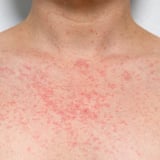
Sunburn, tan lines, and sweaty skin are all things people tend to experience throughout the summer months. While protecting your skin from the sun can help prevent the more unpleasant side effects of the warm weather, some things, like heat rashes, can have a mind of their own.
Whether you've personally experienced heat rashes or you know someone else who has, they can be a common problem during the summer and seemingly come out of nowhere. A heat rash is characterized by stinging or prickling skin and is exacerbated by sweat. You'll usually notice a heat rash appearing on your neck, scalp, chest, legs, and elbow crease.
But what exactly is a heat rash, and why does it itch? What causes it to occur? We spoke with dermatologists to help us answer these burning (pun intended) questions and get a better understanding of heat rashes so you know what to do when one pops up.
Experts Featured in This Article
Kseniya Kobets, MD, MHS, FAAD, is a board-certified dermatologist.
Marisa Garshick, MD, is a board-certified dermatologist and clinical assistant professor at Cornell New York Presbyterian.
What Causes a Heat Rash?
There are a few things that can cause a heat rash to occur; all of them are related to the increased temperature of ultraviolet radiation during the summer months. "Heat rashes on sun-exposed areas like on the chest or arms can happen when someone is sensitive to the sun, and this reaction can sometimes be related to autoimmune disorders," board-certified dermatologist Kseniya Kobets tells PS.
It happens because your sweat gets trapped in the sweat ducts and can't reach the surface of the skin to evaporate. "This blockage can cause inflammation and a rash of red bumps or blisters," board-certified dermatologist Marisa Garshick says. "The condition is often a result of hot and humid weather, excessive sweating, or overheating."
Heat rash can also occur when someone has a sensitivity or an allergy to a chemical SPF ingredient such as avobenzone, oxybenzone, or a fragrance. This can likely "cause a reaction on skin that is hot and sweaty by penetration through pores," Dr. Kobets says. "Other times, heat rashes on legs, which are more red like cayenne pepper, can be related to heat and sun, called pigmented purpuric dermatosis, which usually is a benign and self-limiting rash." Friton can also play a role.
Heat rashes on your neck tend to happen because "the neck is particularly vulnerable due to its exposure to the sun and tight clothing or accessories that can trap heat," Dr. Garshick says.
These parts of your body also have a stagnant blood supply and can "possibly cause an accumulation of immune cells" to create the reaction of the heat rashes, Dr. Kobets says.
Heat Rash Symptoms
Usually, a heat rash manifests as red clusters of small blisters or pimples. But do heat rashes itch? Unfortunately, yes. Heat rashes can potentially itch, and the sensation can range from mild to severe, our dermatologists say. "The discomfort from itching can lead to scratching, which might worsen the condition," Dr. Garshick says. However, it's possible that you may not experience any itchiness.
"It commonly occurs in areas where sweat is trapped under the skin, such as the back, neck, chest, groin, and armpits," Dr. Kobets says. "Other symptoms may include mild swelling, stinging, and it may also be associated with pain."
Do Heat Rashes Spread?
When you think of a rash, you may figure that it will spread to other areas of your body. Luckily, heat rashes don't usually spread from one area of the body to another because they're not contagious. That said, Dr. Garshick says, "They can cover larger areas if the conditions that caused the rash continue, such as excessive sweating or heat exposure."
How to Get Rid of Heat Rashes
To get rid of heat rashes, you'll want to keep the affected area cool and dry and wear loose, lightweight clothing. This allows your skin to breathe. "Apply cold compresses to reduce itching and inflammation. Avoid heavy creams or ointments that can block pores and worsen the condition. Using hydrocortisone cream can soothe irritation," Dr. Kobets says. "Ensure you stay hydrated and in a cool environment to prevent excessive sweating. If the heat rash persists or becomes infected, consult a healthcare professional for further treatment."
How Long Do Heat Rashes Last?
There's really no head and fast timeline when it comes to how long a heat rash will last. "This varies depending on how quickly the skin is cooled and dried," Dr. Garshick says. "Most heat rashes resolve within a few days to a week. It might take longer if the skin continues to be exposed to heat and sweat."
Sydney Wingfield has been a freelance writer in the beauty and wellness space for six years. She has written for Women's Health, Marie Claire, Glamour, and other publications and loves to cover all things skin care, makeup, and hair.
